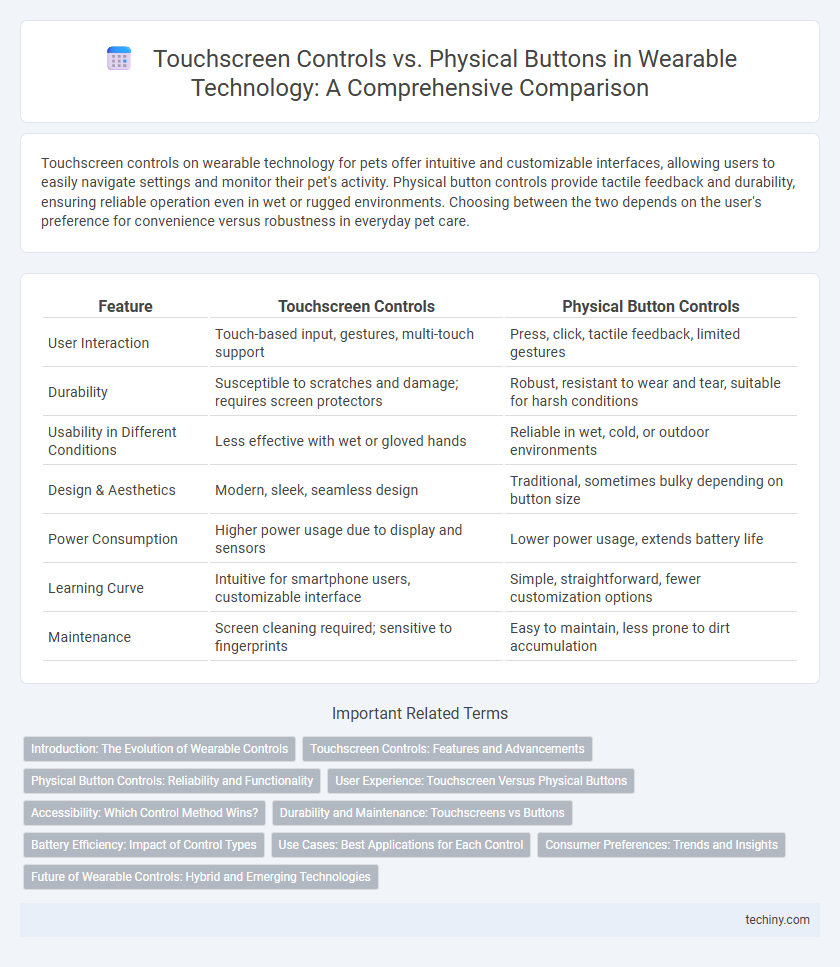Touchscreen controls on wearable technology for pets offer intuitive and customizable interfaces, allowing users to easily navigate settings and monitor their pet's activity. Physical button controls provide tactile feedback and durability, ensuring reliable operation even in wet or rugged environments. Choosing between the two depends on the user's preference for convenience versus robustness in everyday pet care.
Table of Comparison
| Feature | Touchscreen Controls | Physical Button Controls |
|---|---|---|
| User Interaction | Touch-based input, gestures, multi-touch support | Press, click, tactile feedback, limited gestures |
| Durability | Susceptible to scratches and damage; requires screen protectors | Robust, resistant to wear and tear, suitable for harsh conditions |
| Usability in Different Conditions | Less effective with wet or gloved hands | Reliable in wet, cold, or outdoor environments |
| Design & Aesthetics | Modern, sleek, seamless design | Traditional, sometimes bulky depending on button size |
| Power Consumption | Higher power usage due to display and sensors | Lower power usage, extends battery life |
| Learning Curve | Intuitive for smartphone users, customizable interface | Simple, straightforward, fewer customization options |
| Maintenance | Screen cleaning required; sensitive to fingerprints | Easy to maintain, less prone to dirt accumulation |
Introduction: The Evolution of Wearable Controls
Wearable technology has evolved from relying solely on physical button controls to incorporating advanced touchscreen interfaces, enhancing user interaction and functionality. Early models favored tactile buttons for durability and simplicity, but modern devices integrate capacitive touchscreens to enable gestures and multi-touch inputs. This shift reflects advancements in sensor technology and user demand for more intuitive, versatile control methods in compact wearable designs.
Touchscreen Controls: Features and Advancements
Touchscreen controls in wearable technology offer enhanced interactivity through multi-touch gestures, allowing users to navigate apps and notifications with intuitive swipes and taps. Advanced resistive and capacitive touchscreens provide high sensitivity and responsiveness, supporting features like haptic feedback and gesture recognition. Recent innovations include curved displays and always-on screen modes, which improve usability and energy efficiency in smartwatches and fitness trackers.
Physical Button Controls: Reliability and Functionality
Physical button controls on wearable technology offer superior reliability in various environmental conditions, including wet or gloved use, where touchscreens often fail to respond. These tactile inputs provide precise functionality without relying on screen calibration or power-hungry sensors, enhancing user experience during physical activities. Devices with physical buttons also benefit from less accidental activation, ensuring consistent performance in critical moments such as fitness tracking or emergency alerts.
User Experience: Touchscreen Versus Physical Buttons
Touchscreen controls on wearable technology offer intuitive navigation and customizable interfaces, enhancing user interaction through responsive gestures and dynamic displays. Physical button controls provide tactile feedback and reliability in various conditions, ensuring accurate input without visual dependence, especially during physical activities or in wet environments. Combining both control methods can optimize user experience by balancing ease of use, accessibility, and operational precision.
Accessibility: Which Control Method Wins?
Touchscreen controls offer customizable interfaces and gesture-based navigation, enhancing accessibility for users with limited dexterity or visual impairments through features like voice commands and haptic feedback. Physical button controls provide tactile feedback and easier operation without visual attention, benefiting users with sensory or motor challenges. The optimal control method depends on individual accessibility needs, with many wearable devices integrating both to maximize usability.
Durability and Maintenance: Touchscreens vs Buttons
Touchscreen controls on wearable technology offer sleek designs but are prone to scratches and require frequent cleaning to maintain responsiveness, impacting long-term durability. Physical button controls, often made from robust materials like stainless steel or rubber, withstand harsh conditions and rough handling, reducing maintenance needs and extending device lifespan. Users seeking endurance and minimal upkeep favor physical buttons for their resilience in diverse environments.
Battery Efficiency: Impact of Control Types
Touchscreen controls on wearable technology often consume more battery power compared to physical button controls due to the continuous use of display backlighting and capacitive sensors. Physical buttons activate specific functions with minimal energy usage, extending battery life significantly in devices like fitness trackers and smartwatches. Efficient battery management in wearables favors physical buttons for tasks requiring frequent input, balancing user interaction with power conservation.
Use Cases: Best Applications for Each Control
Touchscreen controls excel in wearable technology for applications requiring customizable interfaces and dynamic content display, such as fitness tracking and health monitoring apps that benefit from gesture-based navigation and real-time data visualization. Physical button controls are ideal for rugged environments and activities like outdoor sports or industrial use, where gloves or moisture prevent effective touchscreen interaction, ensuring reliable operation under challenging conditions. Selecting the appropriate control type depends on user context, with touchscreens favored for versatility and physical buttons preferred for durability and tactile feedback.
Consumer Preferences: Trends and Insights
Consumer preferences in wearable technology reveal a growing favor for touchscreen controls due to their intuitive interface and adaptability for diverse functions. Physical button controls remain preferred in rugged or sports-focused wearables, offering tactile feedback and reliability under intense conditions. Market analysis indicates a trend towards hybrid designs that combine touchscreens with customizable physical buttons to enhance user experience and accessibility.
Future of Wearable Controls: Hybrid and Emerging Technologies
The future of wearable controls lies in hybrid interfaces that combine touchscreen responsiveness with the tactile feedback of physical buttons, enhancing user experience and accessibility. Emerging technologies such as haptic feedback, gesture recognition, and flexible displays are driving this evolution, enabling more intuitive and precise interaction with wearable devices. These advancements promise seamless integration of control methods, optimizing functionality across diverse use scenarios in fitness tracking, health monitoring, and augmented reality.
Touchscreen Controls vs Physical Button Controls Infographic

 techiny.com
techiny.com